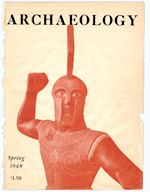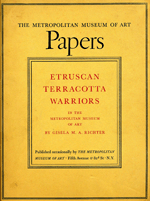Evidence shows that being a great art historian may not
qualify you for detective work
On Valentine's Day 1961, the Met issued the following statement:
The
Metropolitan Museum of Art announced yesterday that, as a result of recently
completed studies, its three "Etruscan" terracotta statues must be
considered of doubtful authenticity. For some years there have been conflicting
claims about these statues on stylistic grounds. Recently the staff of the
Museum began a series of modern scientific and technical analyses. These
developed convincing proof that these famous statues were not made in ancient
times.
It was, according to Time
Magazine, the first time in its
history that "the Met had to announce that it was housing a fake."
Put on display in 1933, the statues included an "old" or
"life-size" warrior, a "colossal" head of a warrior, and a "big"
or "heroic-size" warrior. In his foreword to An Inquiry into the Forgery of the
Etruscan Terracotta Warriors in the MMA (1961), the Met's director James J. Rorimer noted that studies by the
museum's Joseph V. Noble "provided the
first technical evidence of their
having been made in modern times" and that "this evidence was
completely corroborated on January 5, 1961, when Alfredo Fioravanti signed a sworn statement that he had help make the
terracottas" (italics added). What Rorimer didn't say was that this
followed years of inept investigating by the museum and that the warriors
could have been spotted as fakes decades before. There were several red flags. The preservation
of the warriors was simply too good to be true. They were supposedly dug up in pieces, yet they
were "still resplendent in their original colors," wrote Gisela Richter, the Met's curator who
described them in the 1937 publication Etruscan
Terracotta Warriors in the MMA.
When reassembled, the warriors proved to have only a single vent hole, another
tip off. In the 1961 report, Met curator Dietrich Von Bothmer wrote
although
the warriors had each obviously been made in one piece, it would have been
technically impossible to fire them whole: there had been no adequate provision
for the circulation of air necessary during the drying and firing of the clay,
which, in ancient terracottas, had been assured by a proper disposition of
ventholes.
In the same report, Joseph V. Noble summarized results of a close
inspection of the warriors:
Certain fractured areas...do not properly join; where this would have been obvious, the edges of the break have been chipped away to hide the telltale flaws. This suggested that the figures had warped and cracked in drying and probably were already in fragments before firing.
These observations all could have been made early on, exposing the
warriors as fakes. How was Gisela Richter, a renowned authority on ancient
sculpture, taken in? Partly because the statues fulfilled expectations. In her
volume about them, she noted that ancient Latin writers had mentioned Etruscan
sculptures "in terms of wonder and admiration." Well, here were
statues worthy of the description. The terracottas also came via a trusted
intermediary, John Marshall, who was the museum's purchasing agent. Thomas
Hoving, in False Impressions, is uncharitable: "One presumes she was taken
in by the suave John Marshall and then allowed curatorial greed to take over.
Pride no doubt had something to do with her eagerness to acquire these
largest-ever-discovered Etruscan sculptures."
Richter and Marshall both gushed about the terracottas. The old
warrior, she wrote, "will be one of the most dramatic things in the
museum." "I can find nothing approaching it in importance,"
telegraphed Marshall to Rorimer after seeing the colossal head. Richter was
excited about the big warrior: "We have here a representation of a god of
war--and undoubtedly the most imposing conception of such a deity which has
survived from antiquity."
But in, 1936 art dealer Pietro Tozzi wrote Richter, saying he heard in Rome that the
warriors were faked, and he had names: "Fioravanti--Riccardi Bros."
Marshall had passed away, but Richter wrote about this "absurd story"
to his secretary, Annie Rivier. "I don't propose to pay any attention to
it except to ask you to find out who this Fioravanti is and what kind of things
he makes." Rivier looked into it and found Fioravanti was at times a
tailor, car driver, dealer in old furniture, and "he has been for many
years, and still is, a taxi driver in Rome." But Tozzi was dead on. The
forgers were Fioravanti and Riccardo
Riccardi and his cousins Teodoro
and Virgilio Angelino Riccardi.
Doubts about the terracottas mounted. Just months after Richter's 1937
publication of the warriors was published, Massimo Pallotino in Roma (and later in Archeologica Classica), "dimissed all three sculptures in a masterly manner as
forgeries" according to Von
Bothmer. Harold Parsons, who purchased antiquities for American museums,
expressed reservations about them in the early 1940s. During the 1950s several
scholars challenged their authenticity.


Over the years Richter tried to find out more about the source of the
terracottas. Amadeo Riccardi, brother to one of the forgers, was located and
"assisted" the Met in its investigations. Asked about the Attic vase
fragments said to have been found with the statues, he "could not remember
anything definite." He made a map showing Boccaporca, the supposed
findspot of the terracottas, but "stressed the difficulties of going to
Boccaporca--the roads were bad and the locality could not be reached by
car." Amadeo stayed in contact with Richter, ostensibly helping but in
reality delaying and diverting her. He told Richter "the finder (scavatore) was a certain Campanella who died in 1928"
and that, unfortunately, Campanella's son (as fictional as Campanella) was also
dead. Richter planned to go with him "to the spot where he was told the
figures were found (a fountain, however, is said to have been built
there)." One of her later letters says "I have written to Riccardi
since my return, but have as yet no answer. I hope he is investigating."
Von Bothmer summarizes the last acts in Amadeo's charade: "with attacks of
influenza, the spring plowing, and the fields under cultivation, he was not
able to help more."
Harold Parsons began
his own investigations in 1959. He told Time
Magazine that in his conversations
with dealers the name Alfredo Fioravanti kept coming up. Parsons tracked
Fioravanti down and got his story. On January 12, 1961, James Rorimer received
a letter from Parsons along with the translation of a deposition signed by
Alfredo Fioravanti before the American Consul in Rome on January 5. Rorimer
immediately sent Von Bothmer to Rome. Time describes the historic meeting: "In Parsons'
apartment, Von Bothmer produced a plaster cast of one of the warrior's hands,
from which the thumb was missing. Fioravanti in turn produced a thumb of baked
pottery that he had been keeping for years. Placed together, thumb and hand
fitted perfectly."
Fioravanti and the Riccardis were the forgers, but who else swindled the Met
and Miss Richter? The official seller of the old warrior and colossal head was
art dealer Pietro Stettiner. Richter checked him out with her usual
investigative efficiency, "I learned now also [Stettiner] was a high
official at the Post Office and a collector, not a forger. So that is that." But
Stettiner was, as Hoving notes, "crooked." According to Von Bothmer,
Marshall bought 15 objects from Stettiner between 1914 and 1920. One of these,
the upper part of a life-size terracotta statue of a woman bought in 1916, was
shown to be a fake by 1927. "The recognition that an acquisition from a
dealer is a forgery often leads to a re-examination of other objects from the
same source," says Von Bothmer, but that did not happen. If it had, a
series of seven terracotta slabs with sea monsters bought from Stettiner in
1914 would have been exposed as well. It was only in the winter of 1960-1961
that a re-examination revealed stylistic problems, evidence several plaques had been broken before
firing, and that modern coloring agents had been used. (Fioravanti confessed to making them.)
What is most damning is a bronze figurine bought by Marshall in 1919.
Von Bothmer's description borders on comical: it was the top half of woman
joined to the lower part of a man, with an additional mid-section attached with
copper rivet, extra shanks in brass contoured into greaves, and a helmet and a
beard. What was this concocted for? "This weird creation, it seems, could
only have served on purpose: it was meant to unite the various unusual features
of the terracotta sculptures, namely, the elongated proportions (like those of
Italic statuettes) of the old warrior, who wears an "Attic" helmet
with turned-up cheekpieces but a metal cuirass, and the Corinthian
helmet of the colossal bearded head."
Hoving suggests that Marshall should not have been fooled by this
patchwork bronze and that he was may indicate complicity. Whther that is true
or not, it appears that at least five of the 15 objects bought by Marshall from
Stettiner were fakes. That gives added meaning to Met director James Rorimer's
final observation on the warriors: "The facts at hand, as published in
this paper, should bring to a close what, alas, is not an isolated chapter in
the history of collecting."
© 2009 by the
Archaeological Institute of America
archive.archaeology.org/online/features/hoaxes/warriors.html

